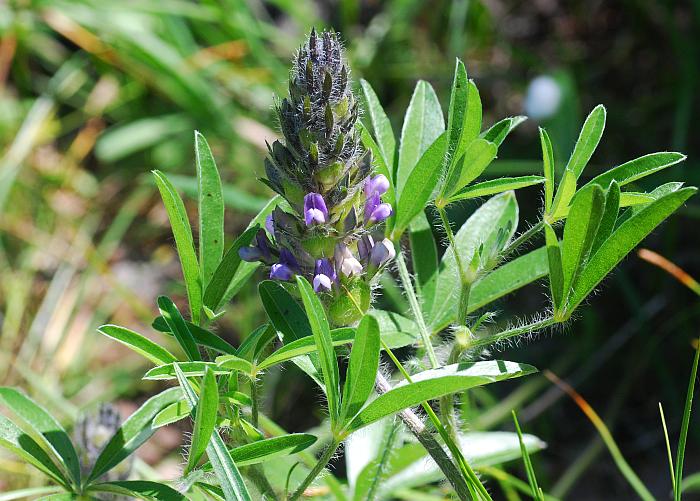Pediomelum esculentum (Pursh) Rydb.
Prairie Turnip

Native
CC = 10
CW = 5
MOC = 20
© SRTurner
Pediomelum esculentum (Pursh) Rydb.Prairie Turnip | |
 |
Native CC = 10 CW = 5 MOC = 20 |
© SRTurner |
|
Family - Fabaceae/Faboideae Habit - Perennial with turnip-shaped, tuberous-thickened taproot. Stems - 1-3, to 30 cm, erect, densely pubescent with long, spreading hairs.
Leaves - Alternate, stipulate, long-petiolate, palmately compound. Stipules 12-18 mm long, lanceolate, hairy. Blades mostly 5-foliate, the leaflets entire, to 5 cm, lanceolate to oblanceolate, with hairy margins, the upper surface glabrous except along the midvein, the lower surface densely pubescent long appressed hairs.
Inflorescences - Dense spikelike racemes, to 6 cm long and 0.8-2.5 cm wide, elongating slightly with age, the stalk 7-11 cm long, the bracts 9-15 mm long, broadly lanceolate to ovate, tapered at the tip, hairy, the flower stalks 1-3 mm long.
Flowers - Calyces long-hairy, the tube 4-5 mm long, somewhat pouched at the base, the upper lobes 4-7 mm long, the lowermost lobe 7-10 mm long. Corollas papilionaceous, 14-18 mm long, lavender to purple or light bluish purple, often bleaching to tan with maturity, the banner sometimes with a darker midnerve and the keel dark purple at the tip. Stamens 10, with 9 of the filaments fused, the fused portion 10-11 mm long, the free portion 1-3 mm long.
Fruits - Modified legumes, to 6 mm long, oblong, glabrous, sessile, abruptly tapered to a curved hairy beak, the surfaces papery, 1-seeded. Seeds 4-5 mm long, olive green to reddish brown, sometimes with darker streaks or mottling, smooth, somewhat shiny. Flowering - April - July. Habitat - Glades, upland prairies, bluff tops. Origin - Native to the U.S. Lookalikes - None when flowering. Leaves are similar to those of lupines, which do not occur wild in Missouri. Other info. - This plant is fairly uncommon in Missouri. The main part of its natural range extends in a band northwestward from Missouri through much of Montana. The plant is easily recognized by its 5-foliate leaves, extreme hairiness, and large inflorescences. It is highly conservative, with a conservatism rank of 10. Photographs taken at Valley View Glade Natural Area, Jefferson County, MO, 5-30-2009, 5-24-2014, and 5-8-2017 (SRTurner). |